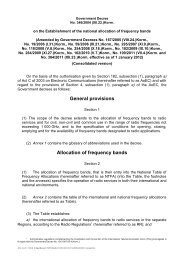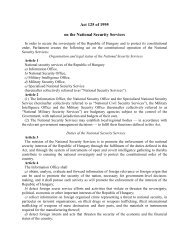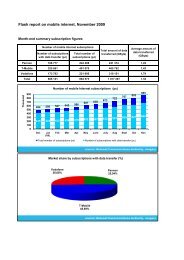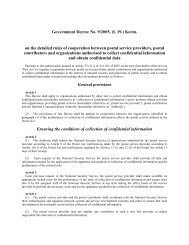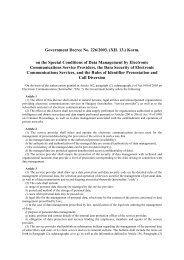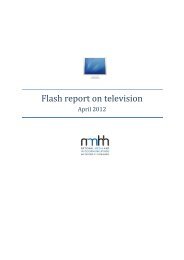The Hungarian Communications Market Developments and ...
The Hungarian Communications Market Developments and ...
The Hungarian Communications Market Developments and ...
Create successful ePaper yourself
Turn your PDF publications into a flip-book with our unique Google optimized e-Paper software.
62 63<br />
postponed to the distant future, instead, it was to be reached as<br />
soon as possible.<br />
In consideration of the two aspects mentioned above, the Board<br />
approved a schedule (glide path) based on equal principles relating<br />
to all three mobile service providers, while also considering the initial<br />
differences, which stipulated the way mobile service providers were to<br />
achieve the cost-based call termination rate deemed as a target value.<br />
Service providers opposed the decisions 33 <strong>and</strong> they applied<br />
the so-called “reservation of rights”, i.e. as the court immediately<br />
refused their proposal for the suspension of the execution of the<br />
decisions, they did execute the rate reductions as specified, but they<br />
declared that if the court repealed the decision of NHH, they would<br />
dem<strong>and</strong> service providers initiating the traffic of mobile termination<br />
to pay for their loss of revenue due to the differences.<br />
According to the decisions of the Board, mobile termination rates<br />
significantly decreased <strong>and</strong> the rates of service providers came<br />
closer to each other.<br />
Termination rates decreasing <strong>and</strong> converging to each other as a<br />
result of the regulation caused a drop in revenues for every mobile<br />
service provider in the case of calls originated from fixed networks<br />
<strong>and</strong>, in the case of mobile-to-mobile calls, they lead to income rearrangement<br />
between service providers.<br />
Although traffic relations do have an influence on the balance of<br />
call termination expenses <strong>and</strong> revenues relating to mobile-to-mobile<br />
calls, the differences between the incomes of service providers are<br />
primarily attributable to different call termination rates.<br />
One of the key objectives of regulation was the elimination of the<br />
unjustifiable differences in the termination rates of mobile service<br />
providers, which is to be attained by 2009. This means that the unjustified<br />
revenue of service providers applying higher rates by putting<br />
other service providers in a disadvantageous situation should be<br />
terminated, therefore the regulation is to be considered as a means<br />
of rectifying the situation with a view to reaching the required conditions<br />
<strong>and</strong> not as a means of “punishment”.<br />
Figure 4.20: Changes in regulated termination rates<br />
HUF/min<br />
40<br />
Vodafone<br />
35<br />
Pannon<br />
Magyar Telekom<br />
30<br />
25<br />
20<br />
15<br />
31.12.2003<br />
31.12.2004<br />
25.05.2005<br />
02.02.2007<br />
01.01.2008<br />
01.01.2009<br />
Source: NHH<br />
According to the schedule set forth in the decision, the rates to<br />
be introduced as of 1 January 2009 shall be 50 percent lower than<br />
the termination rates at the end of 2003. According to the schedule,<br />
in 2009, differences between the termination rates of the diverse<br />
service providers will completely disappear.<br />
<strong>Market</strong> effects<br />
Effects of the decrease in termination rates on mobile service<br />
providers<br />
For mobile service providers, the decrease in mobile termination<br />
rates involves both a decrease in revenues <strong>and</strong> a decrease in expenses<br />
(because of the decrease in pay-off to other mobile service<br />
providers).<br />
Effects of the decrease in termination rates on fixed-mobile<br />
retail prices<br />
At fixed service providers, the costs of fixed-to-mobile direction calls<br />
comprise of retail expenses, the costs of the fixed call origination (transit<br />
rates, if any), <strong>and</strong> the mobile call termination rate. Should the latter costelement<br />
decrease, the profit of the fixed service providers grows. This<br />
increases the room for manoeuvre for the service providers in terms of<br />
competition, <strong>and</strong> may encourage new players to enter the market. As<br />
a result of competition, however, retail prices decrease, which finally<br />
causes lower mobile termination rates to be realised at fixed consumers,<br />
instead of increasing the profit of fixed service providers.<br />
Upon the decrease in mobile termination rates, the decrease in<br />
retail prices of fixed mobile services in the case of universal service<br />
packages is also stipulated by law, in addition to the process based<br />
on market mechanism.<br />
<strong>The</strong> Office of the National <strong>Communications</strong> Authority performed<br />
an official control procedure relating to 2005-2006 to investigate<br />
the fulfilment of this obligation. <strong>The</strong> investigation revealed that in<br />
2005 among the universal service providers T-Com <strong>and</strong> Invitel did<br />
not pass on the decrease in mobile termination rates to subscribers,<br />
while Hungarotel, Emitel <strong>and</strong> Monortel did so only partially (either to<br />
residential or to business subscribers exclusively) .<br />
<strong>The</strong> results of the investigation cannot be generalised for the complete<br />
range of services, as the proportion of the residential subscribers<br />
of universal services was not decisive as compared to all the<br />
subscribers of service providers with significant market power.<br />
<strong>The</strong>refore, NHH compared the development of average fixed-tomobile<br />
retail prices with changes in mobile termination rates during<br />
the periods before <strong>and</strong> after the introduction of regulation (2004-2007).<br />
<strong>The</strong> traffic per minute price collected by fixed service providers<br />
for fixed-to-mobile direction calls (average price) between 2004




